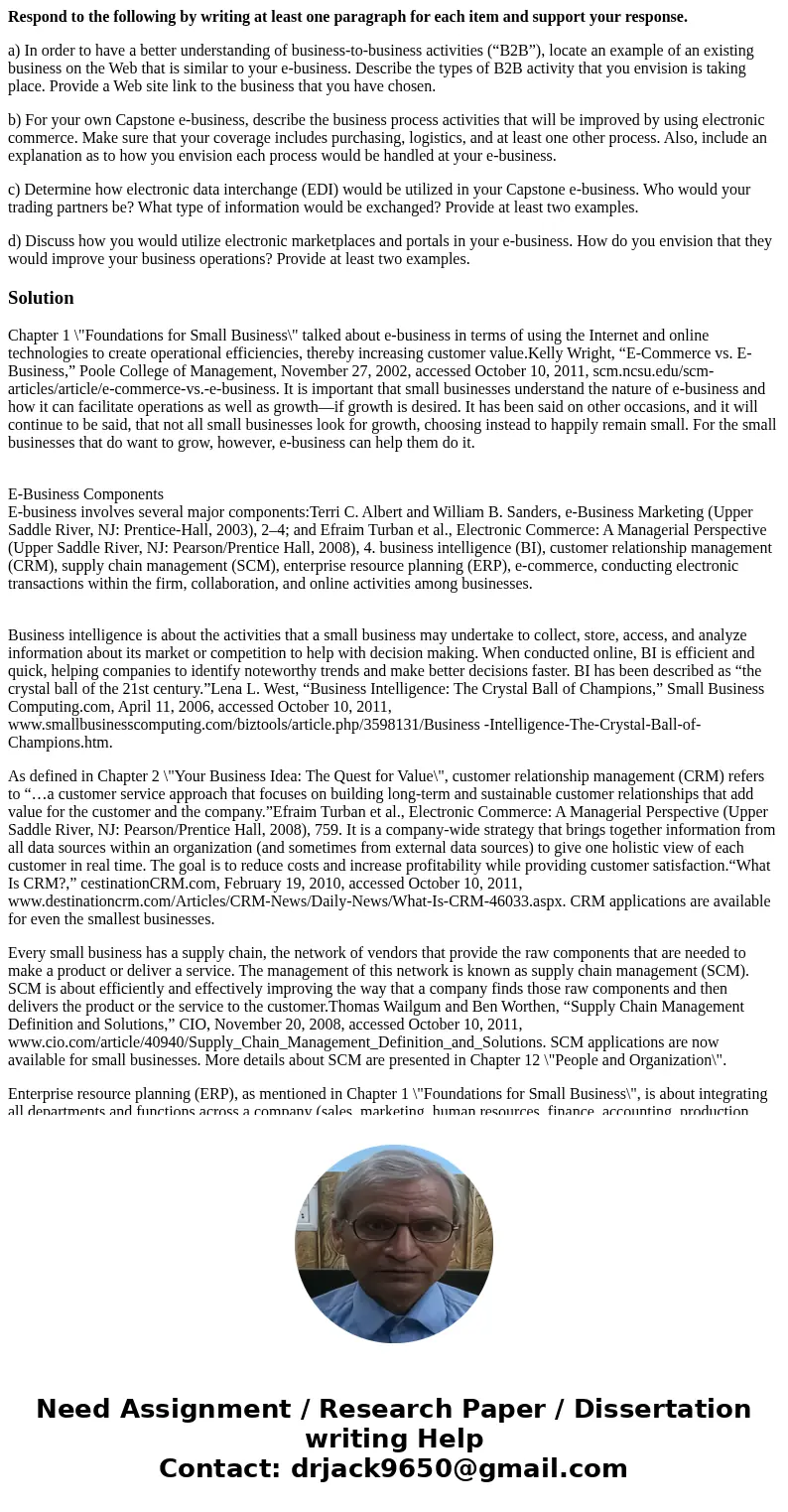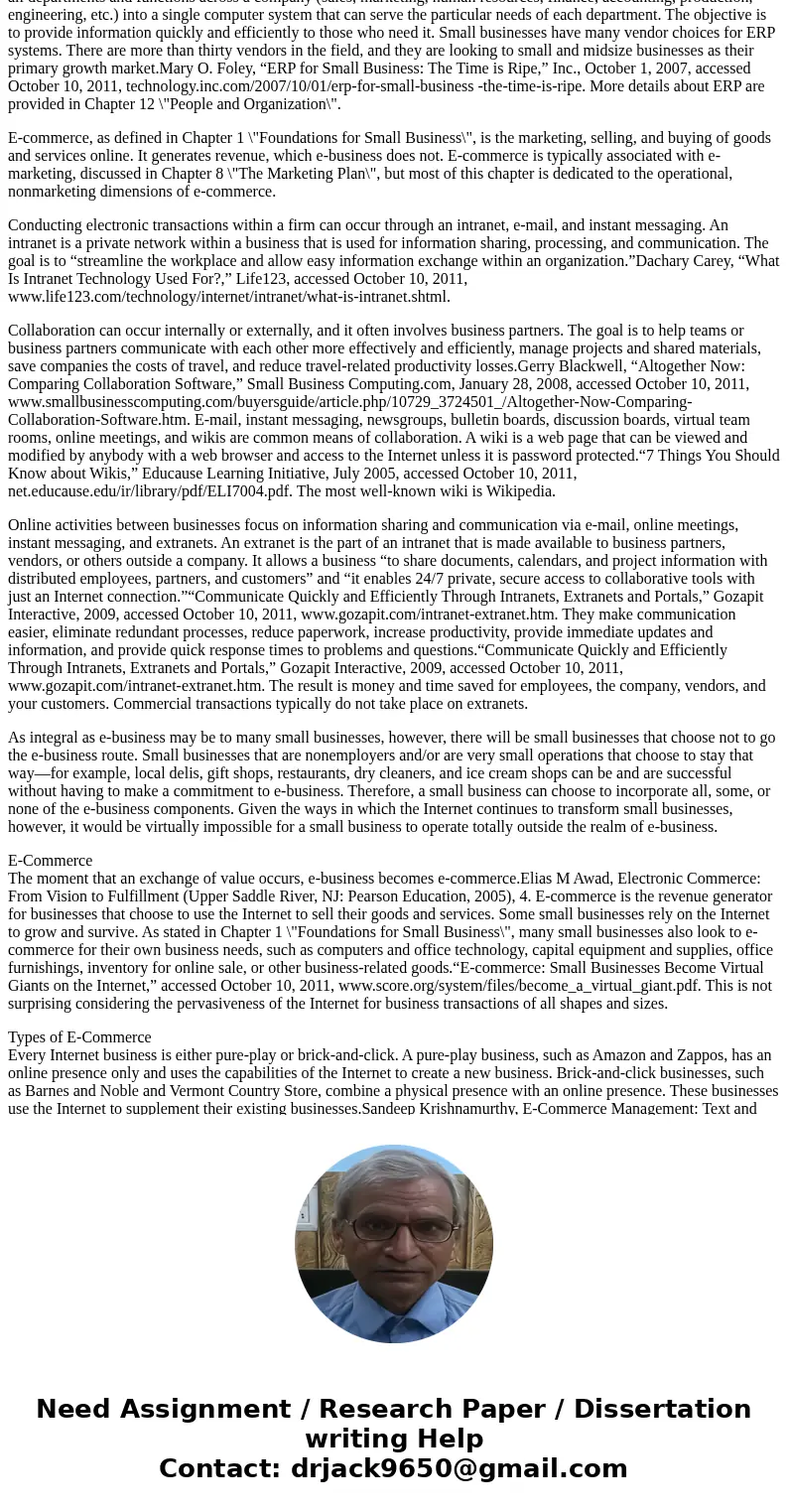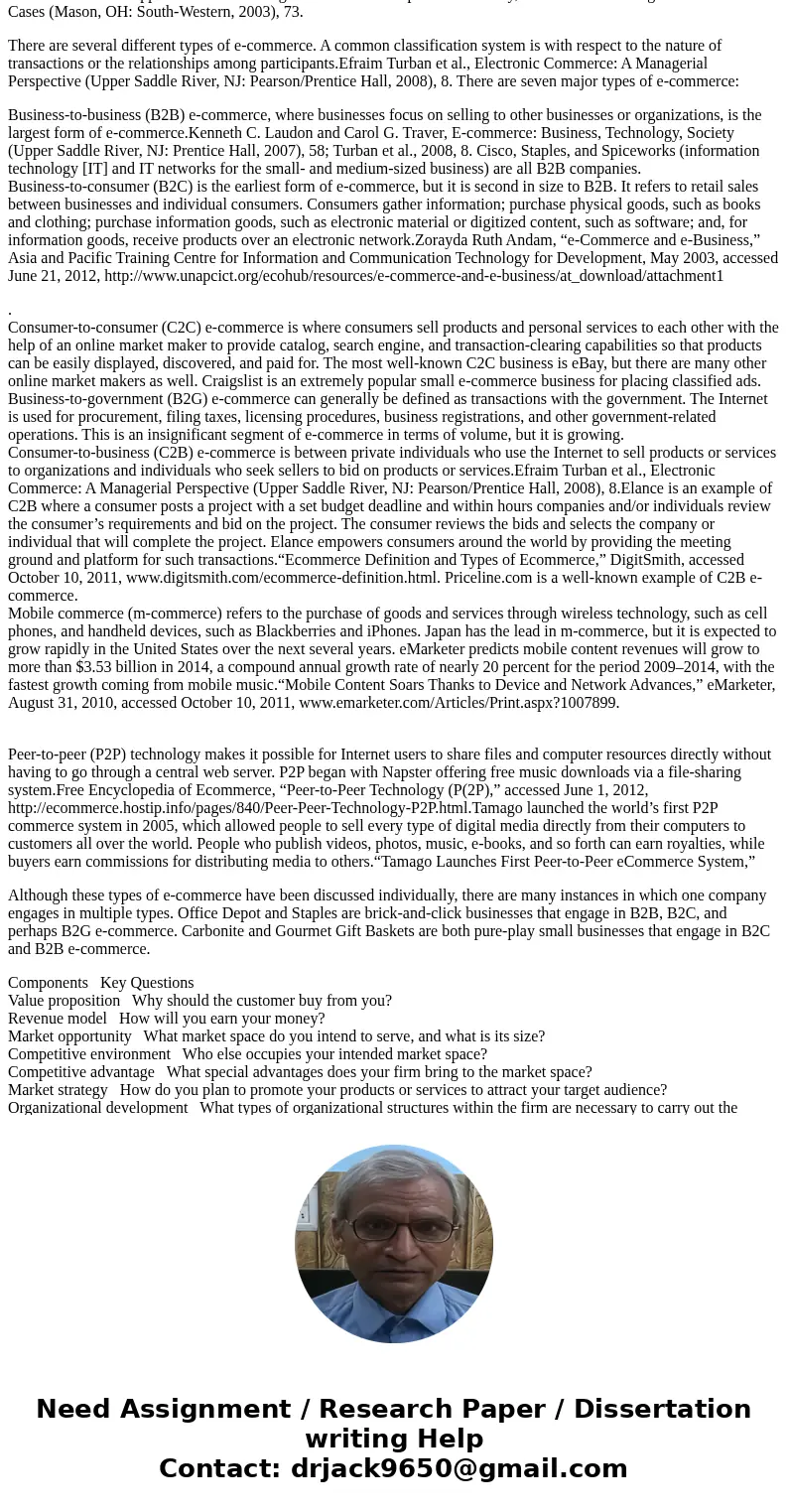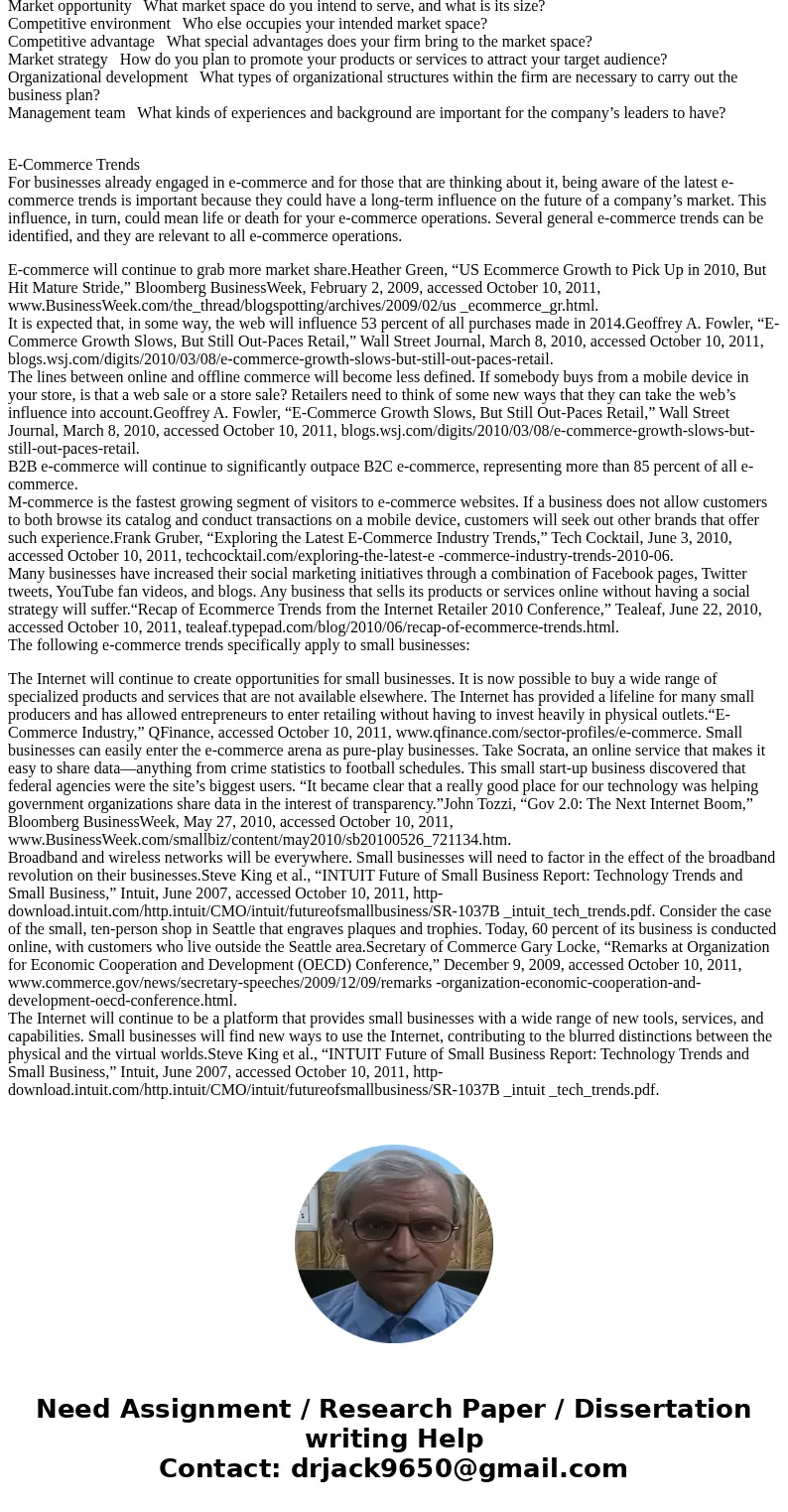Respond to the following by writing at least one paragraph f
Respond to the following by writing at least one paragraph for each item and support your response.
a) In order to have a better understanding of business-to-business activities (“B2B”), locate an example of an existing business on the Web that is similar to your e-business. Describe the types of B2B activity that you envision is taking place. Provide a Web site link to the business that you have chosen.
b) For your own Capstone e-business, describe the business process activities that will be improved by using electronic commerce. Make sure that your coverage includes purchasing, logistics, and at least one other process. Also, include an explanation as to how you envision each process would be handled at your e-business.
c) Determine how electronic data interchange (EDI) would be utilized in your Capstone e-business. Who would your trading partners be? What type of information would be exchanged? Provide at least two examples.
d) Discuss how you would utilize electronic marketplaces and portals in your e-business. How do you envision that they would improve your business operations? Provide at least two examples.
Solution
Chapter 1 \"Foundations for Small Business\" talked about e-business in terms of using the Internet and online technologies to create operational efficiencies, thereby increasing customer value.Kelly Wright, “E-Commerce vs. E-Business,” Poole College of Management, November 27, 2002, accessed October 10, 2011, scm.ncsu.edu/scm-articles/article/e-commerce-vs.-e-business. It is important that small businesses understand the nature of e-business and how it can facilitate operations as well as growth—if growth is desired. It has been said on other occasions, and it will continue to be said, that not all small businesses look for growth, choosing instead to happily remain small. For the small businesses that do want to grow, however, e-business can help them do it.
E-Business Components
E-business involves several major components:Terri C. Albert and William B. Sanders, e-Business Marketing (Upper Saddle River, NJ: Prentice-Hall, 2003), 2–4; and Efraim Turban et al., Electronic Commerce: A Managerial Perspective (Upper Saddle River, NJ: Pearson/Prentice Hall, 2008), 4. business intelligence (BI), customer relationship management (CRM), supply chain management (SCM), enterprise resource planning (ERP), e-commerce, conducting electronic transactions within the firm, collaboration, and online activities among businesses.
Business intelligence is about the activities that a small business may undertake to collect, store, access, and analyze information about its market or competition to help with decision making. When conducted online, BI is efficient and quick, helping companies to identify noteworthy trends and make better decisions faster. BI has been described as “the crystal ball of the 21st century.”Lena L. West, “Business Intelligence: The Crystal Ball of Champions,” Small Business Computing.com, April 11, 2006, accessed October 10, 2011, www.smallbusinesscomputing.com/biztools/article.php/3598131/Business -Intelligence-The-Crystal-Ball-of-Champions.htm.
As defined in Chapter 2 \"Your Business Idea: The Quest for Value\", customer relationship management (CRM) refers to “…a customer service approach that focuses on building long-term and sustainable customer relationships that add value for the customer and the company.”Efraim Turban et al., Electronic Commerce: A Managerial Perspective (Upper Saddle River, NJ: Pearson/Prentice Hall, 2008), 759. It is a company-wide strategy that brings together information from all data sources within an organization (and sometimes from external data sources) to give one holistic view of each customer in real time. The goal is to reduce costs and increase profitability while providing customer satisfaction.“What Is CRM?,” cestinationCRM.com, February 19, 2010, accessed October 10, 2011, www.destinationcrm.com/Articles/CRM-News/Daily-News/What-Is-CRM-46033.aspx. CRM applications are available for even the smallest businesses.
Every small business has a supply chain, the network of vendors that provide the raw components that are needed to make a product or deliver a service. The management of this network is known as supply chain management (SCM). SCM is about efficiently and effectively improving the way that a company finds those raw components and then delivers the product or the service to the customer.Thomas Wailgum and Ben Worthen, “Supply Chain Management Definition and Solutions,” CIO, November 20, 2008, accessed October 10, 2011, www.cio.com/article/40940/Supply_Chain_Management_Definition_and_Solutions. SCM applications are now available for small businesses. More details about SCM are presented in Chapter 12 \"People and Organization\".
Enterprise resource planning (ERP), as mentioned in Chapter 1 \"Foundations for Small Business\", is about integrating all departments and functions across a company (sales, marketing, human resources, finance, accounting, production, engineering, etc.) into a single computer system that can serve the particular needs of each department. The objective is to provide information quickly and efficiently to those who need it. Small businesses have many vendor choices for ERP systems. There are more than thirty vendors in the field, and they are looking to small and midsize businesses as their primary growth market.Mary O. Foley, “ERP for Small Business: The Time is Ripe,” Inc., October 1, 2007, accessed October 10, 2011, technology.inc.com/2007/10/01/erp-for-small-business -the-time-is-ripe. More details about ERP are provided in Chapter 12 \"People and Organization\".
E-commerce, as defined in Chapter 1 \"Foundations for Small Business\", is the marketing, selling, and buying of goods and services online. It generates revenue, which e-business does not. E-commerce is typically associated with e-marketing, discussed in Chapter 8 \"The Marketing Plan\", but most of this chapter is dedicated to the operational, nonmarketing dimensions of e-commerce.
Conducting electronic transactions within a firm can occur through an intranet, e-mail, and instant messaging. An intranet is a private network within a business that is used for information sharing, processing, and communication. The goal is to “streamline the workplace and allow easy information exchange within an organization.”Dachary Carey, “What Is Intranet Technology Used For?,” Life123, accessed October 10, 2011, www.life123.com/technology/internet/intranet/what-is-intranet.shtml.
Collaboration can occur internally or externally, and it often involves business partners. The goal is to help teams or business partners communicate with each other more effectively and efficiently, manage projects and shared materials, save companies the costs of travel, and reduce travel-related productivity losses.Gerry Blackwell, “Altogether Now: Comparing Collaboration Software,” Small Business Computing.com, January 28, 2008, accessed October 10, 2011, www.smallbusinesscomputing.com/buyersguide/article.php/10729_3724501_/Altogether-Now-Comparing-Collaboration-Software.htm. E-mail, instant messaging, newsgroups, bulletin boards, discussion boards, virtual team rooms, online meetings, and wikis are common means of collaboration. A wiki is a web page that can be viewed and modified by anybody with a web browser and access to the Internet unless it is password protected.“7 Things You Should Know about Wikis,” Educause Learning Initiative, July 2005, accessed October 10, 2011, net.educause.edu/ir/library/pdf/ELI7004.pdf. The most well-known wiki is Wikipedia.
Online activities between businesses focus on information sharing and communication via e-mail, online meetings, instant messaging, and extranets. An extranet is the part of an intranet that is made available to business partners, vendors, or others outside a company. It allows a business “to share documents, calendars, and project information with distributed employees, partners, and customers” and “it enables 24/7 private, secure access to collaborative tools with just an Internet connection.”“Communicate Quickly and Efficiently Through Intranets, Extranets and Portals,” Gozapit Interactive, 2009, accessed October 10, 2011, www.gozapit.com/intranet-extranet.htm. They make communication easier, eliminate redundant processes, reduce paperwork, increase productivity, provide immediate updates and information, and provide quick response times to problems and questions.“Communicate Quickly and Efficiently Through Intranets, Extranets and Portals,” Gozapit Interactive, 2009, accessed October 10, 2011, www.gozapit.com/intranet-extranet.htm. The result is money and time saved for employees, the company, vendors, and your customers. Commercial transactions typically do not take place on extranets.
As integral as e-business may be to many small businesses, however, there will be small businesses that choose not to go the e-business route. Small businesses that are nonemployers and/or are very small operations that choose to stay that way—for example, local delis, gift shops, restaurants, dry cleaners, and ice cream shops can be and are successful without having to make a commitment to e-business. Therefore, a small business can choose to incorporate all, some, or none of the e-business components. Given the ways in which the Internet continues to transform small businesses, however, it would be virtually impossible for a small business to operate totally outside the realm of e-business.
E-Commerce
The moment that an exchange of value occurs, e-business becomes e-commerce.Elias M Awad, Electronic Commerce: From Vision to Fulfillment (Upper Saddle River, NJ: Pearson Education, 2005), 4. E-commerce is the revenue generator for businesses that choose to use the Internet to sell their goods and services. Some small businesses rely on the Internet to grow and survive. As stated in Chapter 1 \"Foundations for Small Business\", many small businesses also look to e-commerce for their own business needs, such as computers and office technology, capital equipment and supplies, office furnishings, inventory for online sale, or other business-related goods.“E-commerce: Small Businesses Become Virtual Giants on the Internet,” accessed October 10, 2011, www.score.org/system/files/become_a_virtual_giant.pdf. This is not surprising considering the pervasiveness of the Internet for business transactions of all shapes and sizes.
Types of E-Commerce
Every Internet business is either pure-play or brick-and-click. A pure-play business, such as Amazon and Zappos, has an online presence only and uses the capabilities of the Internet to create a new business. Brick-and-click businesses, such as Barnes and Noble and Vermont Country Store, combine a physical presence with an online presence. These businesses use the Internet to supplement their existing businesses.Sandeep Krishnamurthy, E-Commerce Management: Text and Cases (Mason, OH: South-Western, 2003), 73.
There are several different types of e-commerce. A common classification system is with respect to the nature of transactions or the relationships among participants.Efraim Turban et al., Electronic Commerce: A Managerial Perspective (Upper Saddle River, NJ: Pearson/Prentice Hall, 2008), 8. There are seven major types of e-commerce:
Business-to-business (B2B) e-commerce, where businesses focus on selling to other businesses or organizations, is the largest form of e-commerce.Kenneth C. Laudon and Carol G. Traver, E-commerce: Business, Technology, Society (Upper Saddle River, NJ: Prentice Hall, 2007), 58; Turban et al., 2008, 8. Cisco, Staples, and Spiceworks (information technology [IT] and IT networks for the small- and medium-sized business) are all B2B companies.
Business-to-consumer (B2C) is the earliest form of e-commerce, but it is second in size to B2B. It refers to retail sales between businesses and individual consumers. Consumers gather information; purchase physical goods, such as books and clothing; purchase information goods, such as electronic material or digitized content, such as software; and, for information goods, receive products over an electronic network.Zorayda Ruth Andam, “e-Commerce and e-Business,” Asia and Pacific Training Centre for Information and Communication Technology for Development, May 2003, accessed June 21, 2012, http://www.unapcict.org/ecohub/resources/e-commerce-and-e-business/at_download/attachment1
.
Consumer-to-consumer (C2C) e-commerce is where consumers sell products and personal services to each other with the help of an online market maker to provide catalog, search engine, and transaction-clearing capabilities so that products can be easily displayed, discovered, and paid for. The most well-known C2C business is eBay, but there are many other online market makers as well. Craigslist is an extremely popular small e-commerce business for placing classified ads.
Business-to-government (B2G) e-commerce can generally be defined as transactions with the government. The Internet is used for procurement, filing taxes, licensing procedures, business registrations, and other government-related operations. This is an insignificant segment of e-commerce in terms of volume, but it is growing.
Consumer-to-business (C2B) e-commerce is between private individuals who use the Internet to sell products or services to organizations and individuals who seek sellers to bid on products or services.Efraim Turban et al., Electronic Commerce: A Managerial Perspective (Upper Saddle River, NJ: Pearson/Prentice Hall, 2008), 8.Elance is an example of C2B where a consumer posts a project with a set budget deadline and within hours companies and/or individuals review the consumer’s requirements and bid on the project. The consumer reviews the bids and selects the company or individual that will complete the project. Elance empowers consumers around the world by providing the meeting ground and platform for such transactions.“Ecommerce Definition and Types of Ecommerce,” DigitSmith, accessed October 10, 2011, www.digitsmith.com/ecommerce-definition.html. Priceline.com is a well-known example of C2B e-commerce.
Mobile commerce (m-commerce) refers to the purchase of goods and services through wireless technology, such as cell phones, and handheld devices, such as Blackberries and iPhones. Japan has the lead in m-commerce, but it is expected to grow rapidly in the United States over the next several years. eMarketer predicts mobile content revenues will grow to more than $3.53 billion in 2014, a compound annual growth rate of nearly 20 percent for the period 2009–2014, with the fastest growth coming from mobile music.“Mobile Content Soars Thanks to Device and Network Advances,” eMarketer, August 31, 2010, accessed October 10, 2011, www.emarketer.com/Articles/Print.aspx?1007899.
Peer-to-peer (P2P) technology makes it possible for Internet users to share files and computer resources directly without having to go through a central web server. P2P began with Napster offering free music downloads via a file-sharing system.Free Encyclopedia of Ecommerce, “Peer-to-Peer Technology (P(2P),” accessed June 1, 2012, http://ecommerce.hostip.info/pages/840/Peer-Peer-Technology-P2P.html.Tamago launched the world’s first P2P commerce system in 2005, which allowed people to sell every type of digital media directly from their computers to customers all over the world. People who publish videos, photos, music, e-books, and so forth can earn royalties, while buyers earn commissions for distributing media to others.“Tamago Launches First Peer-to-Peer eCommerce System,”
Although these types of e-commerce have been discussed individually, there are many instances in which one company engages in multiple types. Office Depot and Staples are brick-and-click businesses that engage in B2B, B2C, and perhaps B2G e-commerce. Carbonite and Gourmet Gift Baskets are both pure-play small businesses that engage in B2C and B2B e-commerce.
Components Key Questions
Value proposition Why should the customer buy from you?
Revenue model How will you earn your money?
Market opportunity What market space do you intend to serve, and what is its size?
Competitive environment Who else occupies your intended market space?
Competitive advantage What special advantages does your firm bring to the market space?
Market strategy How do you plan to promote your products or services to attract your target audience?
Organizational development What types of organizational structures within the firm are necessary to carry out the business plan?
Management team What kinds of experiences and background are important for the company’s leaders to have?
E-Commerce Trends
For businesses already engaged in e-commerce and for those that are thinking about it, being aware of the latest e-commerce trends is important because they could have a long-term influence on the future of a company’s market. This influence, in turn, could mean life or death for your e-commerce operations. Several general e-commerce trends can be identified, and they are relevant to all e-commerce operations.
E-commerce will continue to grab more market share.Heather Green, “US Ecommerce Growth to Pick Up in 2010, But Hit Mature Stride,” Bloomberg BusinessWeek, February 2, 2009, accessed October 10, 2011, www.BusinessWeek.com/the_thread/blogspotting/archives/2009/02/us _ecommerce_gr.html.
It is expected that, in some way, the web will influence 53 percent of all purchases made in 2014.Geoffrey A. Fowler, “E-Commerce Growth Slows, But Still Out-Paces Retail,” Wall Street Journal, March 8, 2010, accessed October 10, 2011, blogs.wsj.com/digits/2010/03/08/e-commerce-growth-slows-but-still-out-paces-retail.
The lines between online and offline commerce will become less defined. If somebody buys from a mobile device in your store, is that a web sale or a store sale? Retailers need to think of some new ways that they can take the web’s influence into account.Geoffrey A. Fowler, “E-Commerce Growth Slows, But Still Out-Paces Retail,” Wall Street Journal, March 8, 2010, accessed October 10, 2011, blogs.wsj.com/digits/2010/03/08/e-commerce-growth-slows-but-still-out-paces-retail.
B2B e-commerce will continue to significantly outpace B2C e-commerce, representing more than 85 percent of all e-commerce.
M-commerce is the fastest growing segment of visitors to e-commerce websites. If a business does not allow customers to both browse its catalog and conduct transactions on a mobile device, customers will seek out other brands that offer such experience.Frank Gruber, “Exploring the Latest E-Commerce Industry Trends,” Tech Cocktail, June 3, 2010, accessed October 10, 2011, techcocktail.com/exploring-the-latest-e -commerce-industry-trends-2010-06.
Many businesses have increased their social marketing initiatives through a combination of Facebook pages, Twitter tweets, YouTube fan videos, and blogs. Any business that sells its products or services online without having a social strategy will suffer.“Recap of Ecommerce Trends from the Internet Retailer 2010 Conference,” Tealeaf, June 22, 2010, accessed October 10, 2011, tealeaf.typepad.com/blog/2010/06/recap-of-ecommerce-trends.html.
The following e-commerce trends specifically apply to small businesses:
The Internet will continue to create opportunities for small businesses. It is now possible to buy a wide range of specialized products and services that are not available elsewhere. The Internet has provided a lifeline for many small producers and has allowed entrepreneurs to enter retailing without having to invest heavily in physical outlets.“E-Commerce Industry,” QFinance, accessed October 10, 2011, www.qfinance.com/sector-profiles/e-commerce. Small businesses can easily enter the e-commerce arena as pure-play businesses. Take Socrata, an online service that makes it easy to share data—anything from crime statistics to football schedules. This small start-up business discovered that federal agencies were the site’s biggest users. “It became clear that a really good place for our technology was helping government organizations share data in the interest of transparency.”John Tozzi, “Gov 2.0: The Next Internet Boom,” Bloomberg BusinessWeek, May 27, 2010, accessed October 10, 2011, www.BusinessWeek.com/smallbiz/content/may2010/sb20100526_721134.htm.
Broadband and wireless networks will be everywhere. Small businesses will need to factor in the effect of the broadband revolution on their businesses.Steve King et al., “INTUIT Future of Small Business Report: Technology Trends and Small Business,” Intuit, June 2007, accessed October 10, 2011, http-download.intuit.com/http.intuit/CMO/intuit/futureofsmallbusiness/SR-1037B _intuit_tech_trends.pdf. Consider the case of the small, ten-person shop in Seattle that engraves plaques and trophies. Today, 60 percent of its business is conducted online, with customers who live outside the Seattle area.Secretary of Commerce Gary Locke, “Remarks at Organization for Economic Cooperation and Development (OECD) Conference,” December 9, 2009, accessed October 10, 2011, www.commerce.gov/news/secretary-speeches/2009/12/09/remarks -organization-economic-cooperation-and-development-oecd-conference.html.
The Internet will continue to be a platform that provides small businesses with a wide range of new tools, services, and capabilities. Small businesses will find new ways to use the Internet, contributing to the blurred distinctions between the physical and the virtual worlds.Steve King et al., “INTUIT Future of Small Business Report: Technology Trends and Small Business,” Intuit, June 2007, accessed October 10, 2011, http-download.intuit.com/http.intuit/CMO/intuit/futureofsmallbusiness/SR-1037B _intuit _tech_trends.pdf.




 Homework Sourse
Homework Sourse